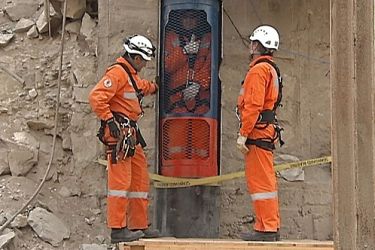Trapped Chile miners set to escape
More than two months after the 33 men got trapped in a dark mining cave, a capsule is to free them on Tuesday night.

The operation to rescue workers trapped in a Chilean mine is expected to take at least 48 hours
Chile is preparing to celebrate the rescue of 33 workers who spent the last 68 days trapped in an underground mining site, in what is expected to test the South America nation’s capability.
Wives, children, parents and friends are waiting on an arid, rocky hillside around 625-metre directly
above them at a tent settlement dubbed “Camp Hope.” An entire nation, still recovering from a devastating February earthquake, is ready to celebrate.
Engineers have completed reinforcing the top of the rescue shaft for the 33 trapped miners.
The work on installing 15 steel tubes was completed on Monday to secure the top 295ft of the shaft.
“The next step is to build a platform above the shaft to support the rescue capsule,” the navy commander in charge of part of the rescue operation, Renato Navarro, said.
Andres Sougarett, the engineer leading the rescue efforts, said his team had successfully tested a rescue capsule almost all the way down to where the miners are trapped and brought it back to the surface.
Laurence Golborne, the Chilean mines minister, said that all is set for the start of the rescue operation of the men around Tuesday midnight (0300 GMT Wednesday), after their over two-month-long ordeal.
A secret list has been prepared listing the order in which the men will be brought up.
The miners’ families are holding their vigil at nearby Camp Hope.
Al Jazeera’s Monica Villamizar, reporting from Copiapo near the mine, said the miners “are not 100 per cent sure that this [rescue operation] will go well; it is a very delicate operation and they are leaving themselves to the Chilean authorities”.
Describing the scene at the camp after the rescue shaft reached the men, Rodrigo Gonzalez, a miner who is related to one of the trapped men, said: “Now that there is even less time to go, we’re getting ready all over Chile to receive those 33 Chileans that are our fellow miners.”
Each of the trapped miners has been promised six months of psychological support by the Chilean government.
Medical preparations
Preparing for the rescue, doctors have ordered the miners to do 20 minutes of aerobic exercise a day to prevent muscle cramps on the way to the surface.
They will also have to fast for eight hours before they come up, and they have been given sunglasses to protect their eyes after so much time in the dark.
Engineers say each capsule trip to the surface could take up to one and a half hours, meaning the entire rescue could last up to two days.
“God be willing, in a few days the whole country will be weeping with joy … when we see these miners emerge from the depths of the mountain to embrace their wives, children, mothers and fathers,” Sebastian Pinera, the Chilean president, said.
Pinera said Evo Morales, the Bolivian president, would join him for the rescue. One of the trapped miners is Bolivian.
Engineers had initially predicted the first rescues would not be until Christmas.
Initially the miners were all thought to have perished. Then after two weeks of silence came an extraordinary note, penned in capitals and written with red ink, that gave Chile the miraculous news that the miners were still alive.
“All 33 of us are well inside the shelter,” the note said.
It was written by the eldest miner, 63-year-old Mario Gomez, and attached to a drill bit which breached their shelter on August 22.
Cameras lowered through small bore holes have revealed pictures of the men, often bare-chested because of the stifling heat, and their shelter lit mainly by the lamps on their hard-hats.
They are in remarkably good health, though some have skin infections from being in damp, humid
conditions for so long.